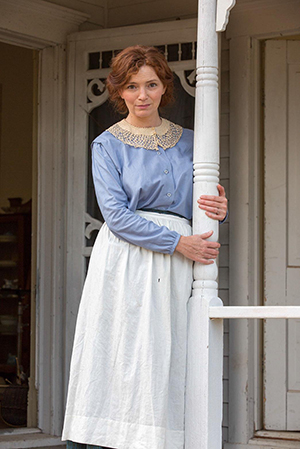‘Te Ata’ filming across Chickasaw Nation, State

This article appeared in the October 2014 edition of the Chickasaw Times
OKLAHOMA CITY – Governor Bill Anoatubby joined a cast of Hollywood’s finest performers Sept. 23 as filming of “Te Ata” continued at the Oklahoma City Railroad Museum.
The film, Gov. Anoatubby said, was a great way to tell the story of the Chickasaw people.
“We are pleased we have such a diverse group of actors involved in telling the story of the impact Te Ata had on her audience and on society,” Gov. Anoatubby said. “Te Ata once wrote that art brings all people together. Her career bears testimony to the truth of that idea as her life’s work did a great deal to help bring diverse cultures closer together. We hope this film will build on that legacy by inspiring a greater sense of understanding.”
Filming began September 8 in Tishomingo, Oklahoma on the feature film based on the life of one of the town’s best known early residents. Award-winning Native American actors in the cast include Q’Orianka Kilcher as Te Ata; Oscar-nominee Graham Greene as Chickasaw Nation Gov. Douglas Johnston; and Gil Birmingham as Te Ata’s father, Thomas Thompson.
Chickasaw actress Jenni Mabrey plays Governor Johnston’s wife, Bettie Johnston, in the film. Ms. Mabrey appeared in the Television series “Party Girl.” She also plays Olivia York in the movie “Stay at Home Dads,” scheduled to be released later this year.
Numerous other Chickasaws served as actors and extras in the film.
Filming in the Tishomingo area included scenes at Pennington Creek, the Chickasaw Nation Capitol, the Chickasaw Bank and the Chickasaw White House. Other locations in Oklahoma include landscapes near the Chickasaw Retreat and Conference Center near Sulphur, as well as historic buildings and historic sites in Sulphur, Guthrie and the Oklahoma City areas.
Known as Te Ata – “bearer of the morning” – the Chickasaw actress, teacher and storyteller entertained powerful political leaders, kings and queens, heads of state and audiences worldwide.
Named Woman of the Year by Ladies’ Home Journal in 1976, Te Ata entertained nationally and internationally, performing for audiences of schoolchildren, presidents, kings and heads of state. Inducted into the Oklahoma Hall of Fame in 1958 and the Chickasaw Nation Hall of Fame in 1990, she received the Oklahoma Governor’s Arts Award in 1975 and was declared Oklahoma’s first “State Treasure” in 1987.
Born in rural Johnston County in 1895, Te Ata lived to be almost 100 years old. She passed away in Oklahoma City in 1995.
Several film locations are set in Guthrie, Oklahoma, including interiors and exteriors of the Masonic Temple there. The structure is the largest building in the world dedicated exclusively to the freemasonry fraternity.
“Te Ata” filming also features the historic Chickasaw Nation Capitol located in Tishomingo. The pink native granite, two-story structure, was completed in 1898 by the Chickasaw Nation. It was the seat of Chickasaw government from 1898 until statehood in 1907. Because of its historic significance and unique architecture, the Capitol was added to the National Register of Historic Places in 1971.
While the Chickasaw National Capitol Building is no longer used for government business, the first and second floors of the Capitol now house exhibit space. The largest exhibit room focuses on Chickasaw government history from 1856 to 1907. Gov. Johnston’s office and the National Secretary’s vault have been recreated to look as they did in 1898.
Rural settings have been filmed along Pennington Creek, a location of historic significance to the Chickasaw people near Tishomingo. The tribe gathered at the aquifer-fed stream for meetings and gatherings after relocated to Oklahoma along the Trail of Tears in 1837.
It is the second movie endeavor of the Chickasaw Nation. “Pearl,” a film about Pearl Carter Scott, a Chickasaw who became a famed teenage aviator under the tutelage of Wiley Post, was completed in 2010.
Filming of “Te Ata” is scheduled to be complete by mid-October.